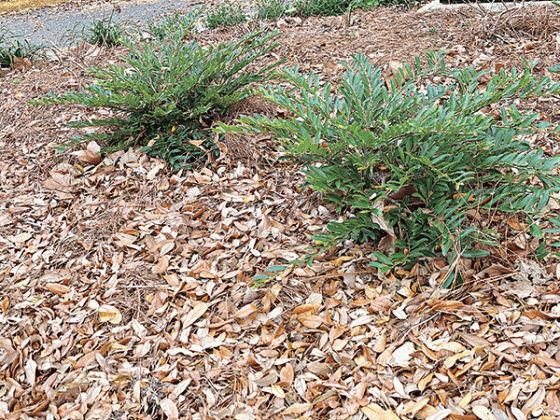
Heather Kirk-Ballard / LSU AgCenter horticulturist
This summer’s extended period of extreme heat and drought has wreaked havoc on all plants great and small. One gardening practice that can make a considerable difference in combating extreme temperatures is mulching.
Mulch can provide several benefits to plants. It helps maintain soil moisture by reducing the amount of water lost to evaporation. It also helps regulate soil temperature.
During hot weather, mulch helps keep the soil cooler by creating a protective barrier between the soil and the external environment. It blocks direct sunlight from contacting the soil and thereby reduces heat absorption. Conversely, in cold weather, mulch provides a layer of insulation that prevents the soil from losing heat.
Mulch helps retain soil moisture by reducing evaporation. When the soil is covered with mulch, it is shielded from the drying effects of both wind and sun. This moisture retention not only benefits plant roots directly but also helps maintain a more stable soil temperature. Dry soil tends to heat up quickly in the sun, which can be detrimental to root health.
In colder temperatures, mulch provides protection against frost. When applied in the fall, mulch can keep the soil temperature more stable, preventing premature freezing and thawing that can damage plant roots during winter.
Mulch helps maintain a consistent environment in the root zone, reducing stress on plant roots. In addition, by preventing weed growth, mulch eliminates competition for water and nutrients, ensuring that the plants you want to support receive the resources they need to thrive, even during droughts.
It’s important to apply mulch correctly to achieve these benefits. The mulch layer should be spread evenly around the base of plants in a sloping mound. Leave some space around the stem or trunk to prevent moisture buildup and potential rot. Regularly replenishing the mulch layer as it breaks down is a good practice to help maintain its insulating properties and ensure long-term benefits for your plants.
Check mulched areas every spring and fall as part of your routine gardening maintenance. Check for thinned areas that need to be replenished with fresh material. The best depth for a mulch layer is 2 to 4 inches. Too thick a layer can reduce oxygen reaching the soil. Too thin, and you give weeds a fighting chance.
There are two main types of mulch: organic and inorganic. Natural, organic mulches include wood chips, shredded bark, pine needles, leaves, compost and even paper or cardboard. Inorganic mulches can be rocks, plastic mulches and landscape fabrics.
One of the main benefits of organic mulches is that, as they decompose, they release nutrients back into the soil. In addition, organic materials can improve aeration of the soil, its overall structure and even enhance drainage.
Each type of mulch material offers benefits — and sometimes, drawbacks. What type you choose ultimately depends on the design, intended use of the area and the types of plants growing there.
Bark mulches are one of the most commonly used, readily available and often the least expensive. Available in larger nuggets or shredded, they come from several types of trees, including pine, cedar and cypress.
When weighing the benefits of bark nuggets versus shredded, be aware that nuggets break down much slower but do not stay in place well. Heavy rains can carry them away, and if not layered at a good depth, they leave large gaps where weeds can grow. Shredded bark provides good coverage and stays in place well but breaks down more quickly than nuggets.
Bark mulches are great for landscape beds but are not recommended for vegetable gardens because they can tie up nitrogen from the soil, making it less available to the plants. However, leaves, pine needles and straw are ideal for vegetable gardens.
Straw mulches, including pine needles, are excellent choices for both vegetable and ornamental landscape beds. They are readily available and affordable. Both help prevent soil from splashing up onto fruits and vegetables when laid properly. In addition, straw is an excellent insulator in the winter and protects against cold temperatures due to its hollow stems.
Fallen leaves are economical because they are free. You’ve got to get them cleaned up, so why not put them to work for you? Additionally, it is a sustainable landscape practice to use fallen leaves as mulch or to make compost.
One other organic option is paper and cardboard. Place a thick layer down and use a few rocks to hold in place or cover it with a thin layer of another type of organic mulch. Voila — you are reusing and reducing waste! Paper will eventually break down.
Mulch is an important tool for dry, hot summers by helping to retain soil moisture, regulating temperature and promoting plant health. It is essential in combating drought and extreme temperatures. Don’t forget to check your mulch depth this fall and replenish where needed.
